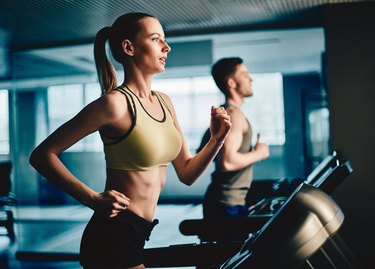
Circuit training involves moving through a series of exercises with little or no rest in between exercises. Exercises, called stations in circuit-training terminology, can be body-weight exercises such as push-ups, weight-lifting exercises, core or even cardio exercises depending on the purpose of the circuit and your fitness goals. It is important to warm up thoroughly before circuit training to maximize the benefits of your workout while minimizing the risk of injury.
Raising Your Pulse
Video of the Day
The first part of a circuit training warm-up is the pulse raiser. The pulse raiser increases blood flow around throughout your body, elevates body temperature and speeds up metabolic activity so that your body is ready for the more demanding exercises to come. Pulse-raising activities include jogging, jumping rope and exercising to music. The pulse raiser should be graduated so that there is an increase in exercise intensity over three to five minutes or more. At the end of the pulse raiser you should feel warm and ready to work out.
Video of the Day
Joint Mobility
Your joints are lubricated by a liquid called synovial fluid which is produced on demand when you move your limbs. To ensure your joints are well lubricated and ready for exercise, you should perform joint-mobility exercises as part of your warm-up. To mobilize your joints, simply take your limbs through a progressively wider range of movement over a series of repetitions. To mobilize your hips and knees, perform shallow knee bends progressing to full-depth squats. To mobilize your shoulders, perform shoulder shrugs progressing to full arm circles. Mobilize all of your major joints to ensure they are well lubricated and ready for exercise.
Stretching
Your muscles tend to shorten throughout the day as a result of your being seated. Stretching before working out reduces your risk of injury and ensures that you can perform your exercises through a full range of movement. The best form of stretching for a warm-up is dynamic stretching. Dynamic stretching involves movements such as leg swings and lunges as opposed to static stretching where positions are held for a predetermined length of time. Dynamic stretches keep your body temperature and heart rate elevated while static stretches tend to promote relaxation and a lowered pulse rate.
Exercise Rehearsal
The final stage of a circuit training warm-up is exercise rehearsal. Exercise rehearsal is an opportunity to learn new exercises and practice ones that you are less familiar with. This stage ensures that you can complete the circuit safely and perform the exercises in the most effective way. Exercise rehearsal involves performing a couple of repetitions of each exercise at a low intensity before starting the first circuit.